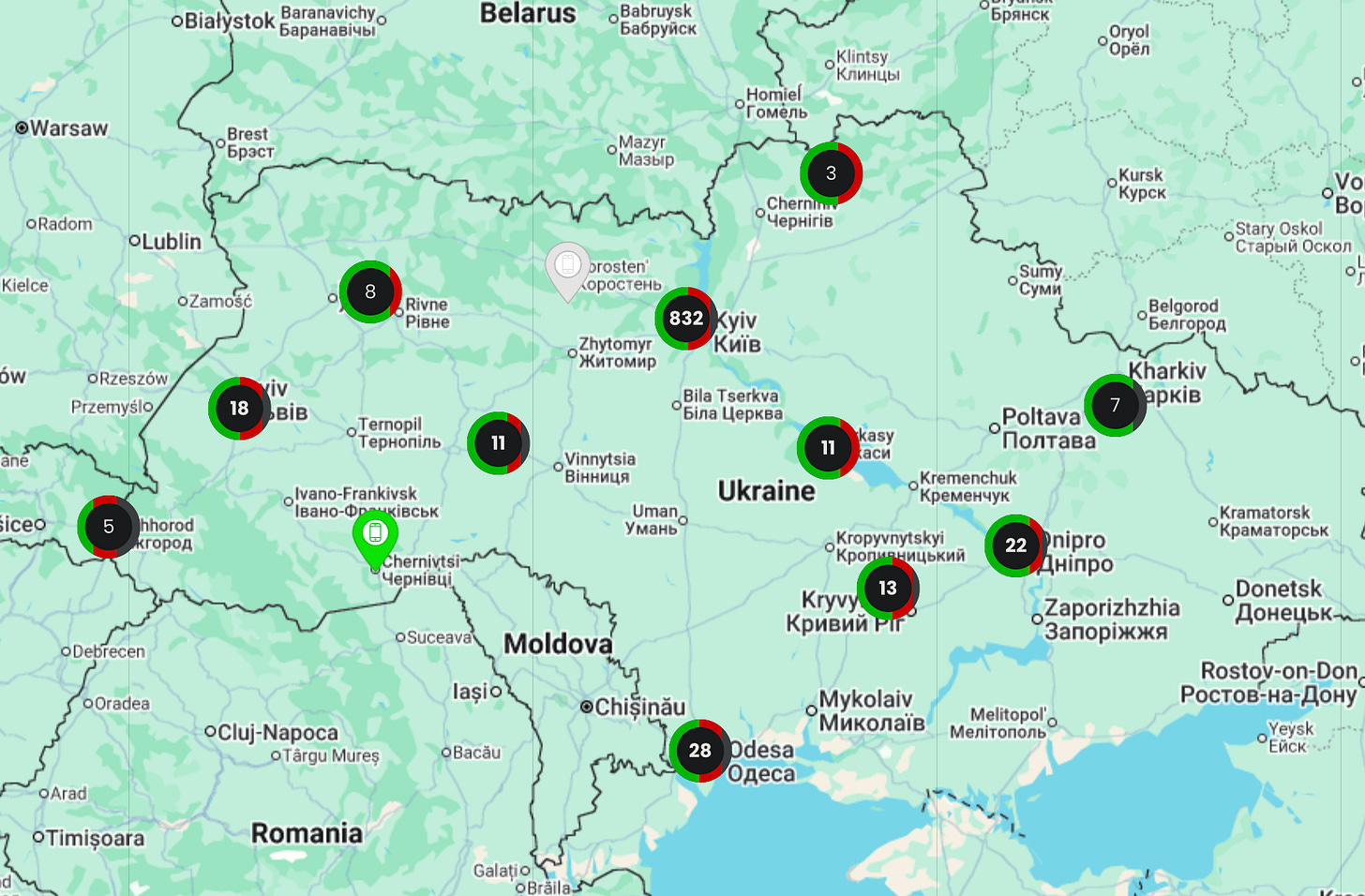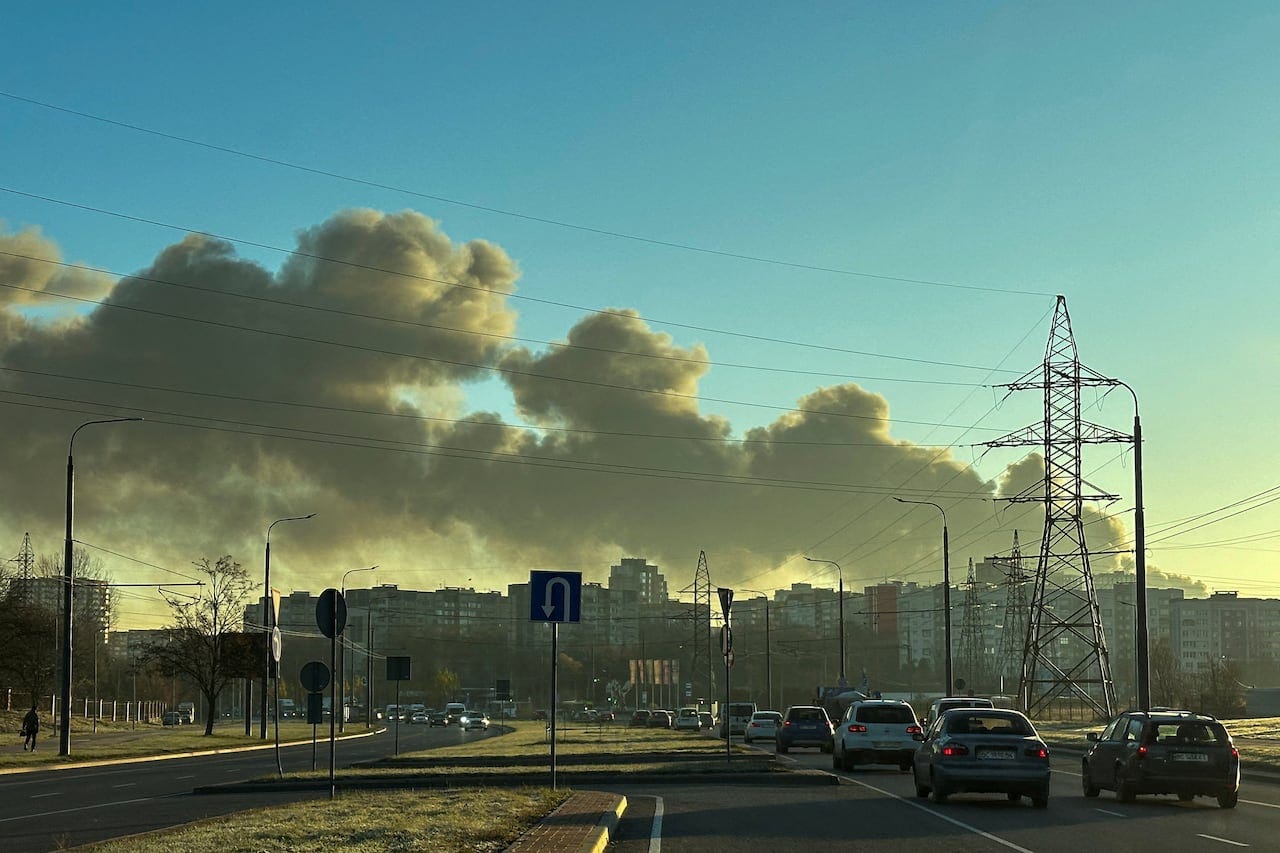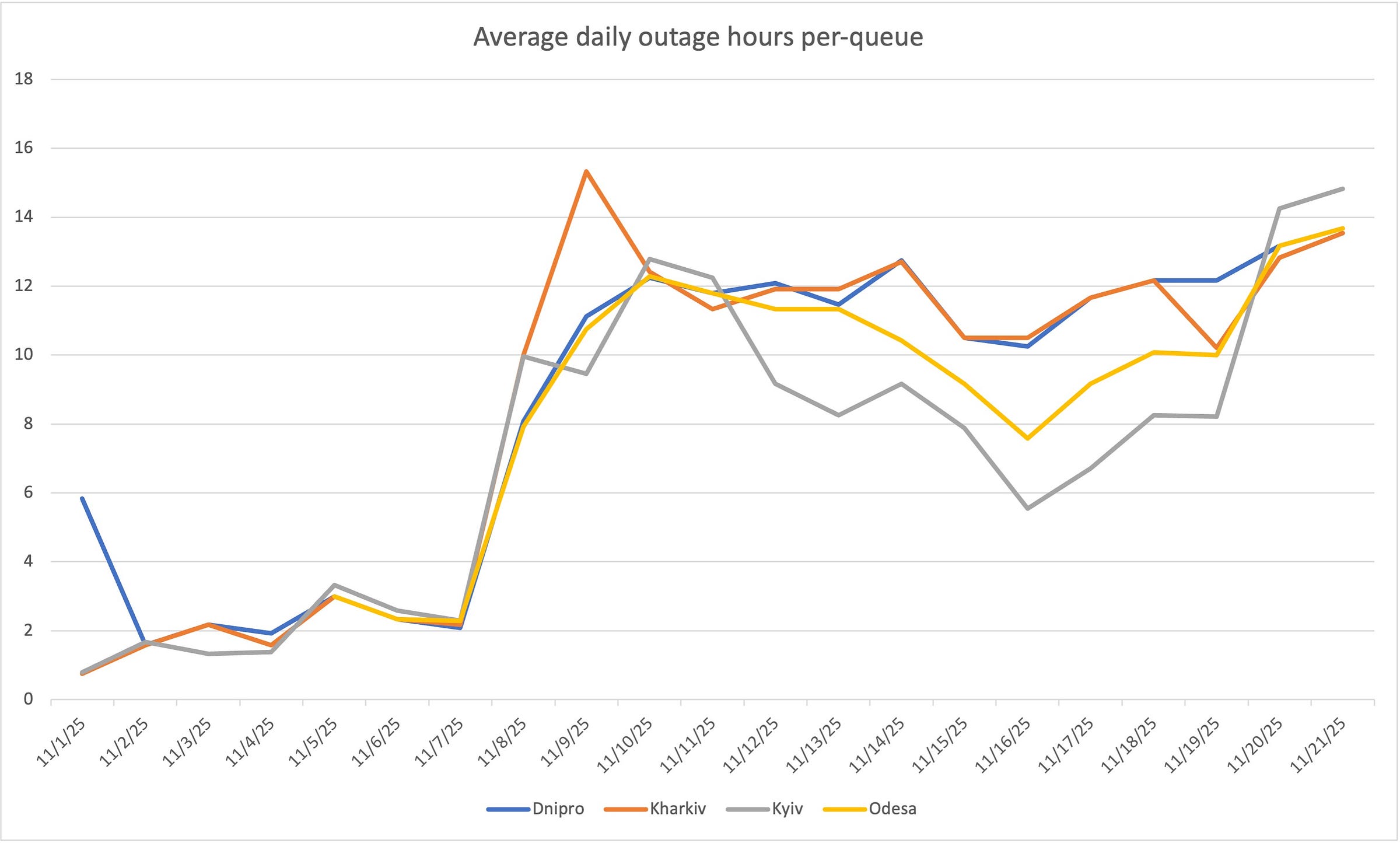Blackout
Evaluating Ukraine's energy crisis
The last time I covered the Russo-Ukrainian energy war, the Russians had just targeted – and apparently destroyed – a key 750kV substation linking the nuclear power plants in the west of the country to the Kiev metro area, and beyond. In that piece, I said the following:
Over the next few days, the blackout schedule for Ukraine as a whole and especially Kiev will be a key signal to watch. If Ukrenergo is unable to restore full service to the city within a few days, the Kievska station was likely completely destroyed.
Today we’ll be evaluating this statement, and will make an attempt to get a clear picture of the Ukrainian grid as a whole. This is a daunting task if hard data is what you’re after, rather than anecdotal reports and typically vague media stories.
Luckily, we have some public information. DTEK, Ukraine’s largest private energy firm, publishes public, daily outage announcements for three service regions: Kiev, Odessa, and Dnipropetrovsk. Using these announcements, we can determine the relative state of the Ukrainian grid, compared to before the major Russian attack on the 7th.
The announcements for Kiev on the 17th of November look like this:
Each city in Ukraine is split into twelve “queues” (черги), or “turns.” Every service address belongs to a queue, and Ukrainians can find out when their lights will be shut off by referencing these images or using an online, address-based tool. Each queue has its own outage schedule, which can vary somewhat from queue to queue. In the first image above, we can see that queue 1.1 will have outages from midnight until 2:30am, and from 8:30am to 12:30pm.
Cities not serviced by DTEK have a smattering of other online tools or Telegram channels that provide outage announcements. One of these is Kharkov:
Here, queue 1.1 will have outages from midnight to 3am, 6:30am to 1:30pm, and 5pm to midnight. Some regions only allow outage lookups by individually selecting a queue or even an address, so they’re not conducive to easily scraping data.
The DTEK announcement images can be downloaded easily enough, but a relatively complex OCR and programatic solution is needed to extract, parse, and process the outage schedules. The Kharkov announcements can be parsed somewhat easily because they’re already in text, and follow a consistent format. Once we have the schedules, we can then total up the number of outage hours for a city within a day, and divide it by 12 (the number of groups) to receive an average number of outage hours that’ll apply city-wide.
After lots of trial and error and burning some free AWS credits on OCR, here’s the result:
First, a caveat: while queues are evenly distributed in terms of energy load, they are not necessarily evenly distributed in terms of customers. So we can’t take the outage hours as a proxy for what the average person in each city is experiencing, since a queue may contain commercial or industrial customers. However, my general assessment of the data is that individual queues are not being singled out for continuous service, and the distribution of outage hours is generally similar across groups when viewed across multiple days. Regardless, we can get a good sense of the relative state of Ukraine’s grid compared to the beginning of the month.
So what does this data show us? The Russian attack that destroyed the Kievska substation and brought the Centrenergo power plants offline is obvious here, with all four cities/regions increasing their outage hours by a factor of six from the 7th to the 9th. We can also see that Kiev has been receiving priority in terms of service, with its hours consistently lower than the others.
Apparent repair efforts appeared to be mitigating the pressure for Kiev and Odessa until a slight reversal on the 16th. A moderately-sized overnight attack on the 16th targeted energy infrastructure, including a 110kV substation, in Odessa oblast.
On the 19th, a major Russian attack using over 60 missiles struck dozens of targets across Ukraine. This attack damaged or destroyed substations and thermal power plants in central and western Ukraine, including in Lvov, Ladyzhyn, and Burshtyn. The effect of this attack is immediately apparent in the data, with Kiev surging to 15 hours of blackouts a day, a peak for the month.
It’s clear that the Ukrainian grid is severely degraded, and continued Russian attacks are doing more than enough to keep up with the rate of repairs. No city we have data for has dropped to less than three times the outage hours it was experiencing before the 7th. Dnipropetrovsk and Kharkov have shown no improvement, and efforts to keep a higher level of service in Kiev have had limited success.
To try to get a sense of how widespread the damage is, we can use SvitloBot, a webapp that tracks outages for connected devices across this country. This is nowhere close to a perfect tool, as large numbers of devices mysteriously go on “technical breaks” and much of the country’s status is unavailable while air alerts are active, which is now much of the average Ukrainian day.

The key takeaway from SvitloBot is that service in western Ukraine has dropped precipitously. Until recently, cities like Lvov were solid green for much more of the day than central and eastern parts of the country, likely because the western regions have been sustained through imported electricity from Poland and Hungary. Ukrainian electricity imports surged from 140 Mwh in September to 360 Mwh in October. But import infrastructure is vulnerable to destabilization through long-range Russian strikes like the one we saw on the 19th.
The available evidence suggests that Russian strikes are outpacing Ukraine’s ability to repair its grid. Two weeks after the strike on the 7th, a generous timeframe to complete major repairs considering how efficient Ukraine’s engineers have become, the situation has only continued to deteriorate. Major urban centers are now without power for the majority of the day. With the situation spiraling out of control, outage schedules have been temporarily discarded in some areas. Ukrenergo announced emergency outages this morning:
The damage to transmission infrastructure has been severe enough that Ukraine’s three nuclear power plants, which provide more than half of its energy, have been forced to further limit their output as their connections to the rest of the country are severed.
A perfect storm is hitting Ukraine, as political, battlefield, and infrastructural pressure mount to unprecedented levels since the war began. Full grid collapse is now on the table. It’s just a question of if the Russians will choose to pull the plug.









I wonder what effect of the corruption has had on this degradation. After all the latest corruption scandal occurred after this attack and centered initially on those currently and formerly in charge of the power grid. How much more survivable or resilient would the power grid have been if the corruption not occurred?
Thanks for the excellent update on what is a difficult issue to get a handle on.
The real issue is what happens when the deep freeze hits and all the water pipes servicing all the buildings are in danger of bursting when impacted by hours long blackouts at irregular intervals.
I know from experience on the receiving end that shutting down and then restarting the urban central heating system in place in Ukraine is a complicated big deal. I can't imagine how it can be done every few hours and still deliver necessary heat to protect all the buildings from degradation.
In warmer weather you can protect people by installing large diesel generators in designated locations. However, that won't do anything to protect buildings against a hostile environment.